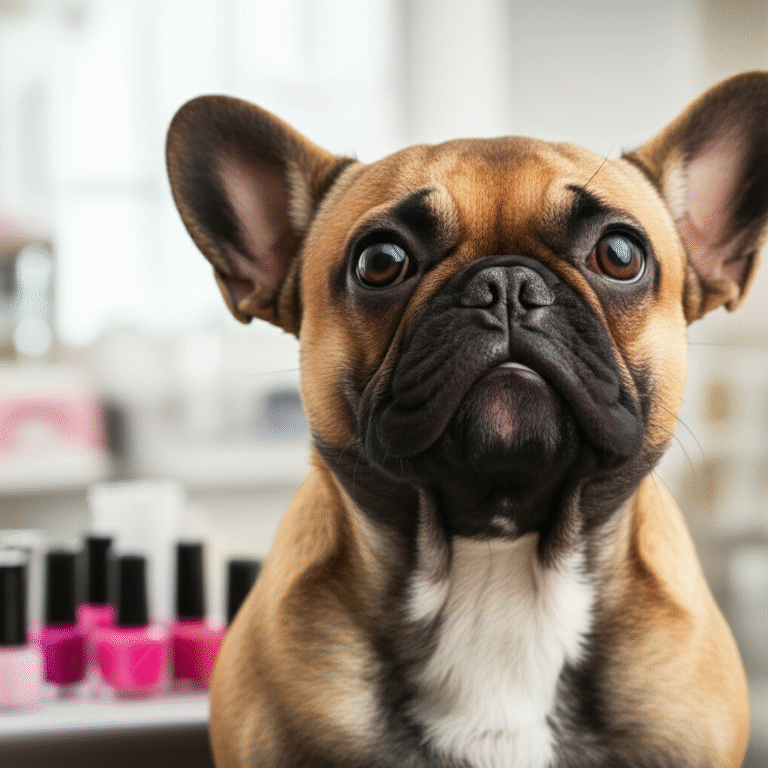Here’s the content you requested, focusing on the crucial topic of nail salon fumes and their impact on our canine companions.
—
A. Bolded Quick Summary
Yes, nail salon fumes are definitely bad for dogs. Exposure to harsh chemicals like acrylic monomers, UV gel resins, and strong solvents can cause respiratory irritation, headaches, and even long-term health issues for your furry friend. Protect your dog by ensuring good ventilation or keeping them away from salon environments during service.
—
B. Intro Paragraph
If you’re a nail salon client or a DIY nail enthusiast, you’re likely familiar with the distinct, often potent aromas that accompany nail services. While we might tolerate these smells for the sake of beautiful nails, have you ever stopped to consider the impact these fumes have on our beloved canine companions? It’s a common concern for pet owners who also happen to be nail art aficionados, and for good reason. The chemicals used in nail products can be quite strong, and our dogs, with their sensitive noses, are far more susceptible to their effects than we are. You’ve come to the right place for clear, practical advice on this important issue. Let’s dive into understanding just how bad nail salon fumes are for dogs and what you can do to keep them safe.
—
C. Main Article Writing Instructions
Are Nail Salon Fumes Bad for Dogs? Understanding the Risks for Your Canine Companion
The vibrant world of nail salons, with its array of polishes, gels, and acrylics, is a sanctuary for many seeking self-expression and beauty. However, the very processes that create stunning manicures and pedicures involve chemicals that can be concerning for pet owners. A frequently asked question, and a critical one at that, is: are nail salon fumes bad for dogs? The answer, unequivocally, is yes. Dogs possess a far more sensitive olfactory system than humans, making them particularly vulnerable to the airborne irritants present in nail salons.
The Chemical Cocktail: What’s in Nail Salon Fumes?

Nail salons utilize a variety of products, each with its own unique chemical composition. Understanding these components is key to grasping why they can be harmful to dogs.
Monomers (especially MMA and EMA): These are the building blocks of acrylic nails. Methyl methacrylate (MMA) is particularly notorious for its strong odor and potential for respiratory irritation. While ethyl methacrylate (EMA) is generally considered safer and more commonly used in professional settings, it still emits fumes.
UV/LED Gel Resins: These light-cured polishes contain acrylates and methacrylates that can be irritating. The curing process itself can release volatile organic compounds (VOCs).
Solvents: Acetone, used for removing polish and acrylics, is a strong solvent with a pungent odor that can cause dizziness and respiratory distress. Other removers and cleaners also contribute to the chemical load.
Adhesives: Glues used for nail tips and embellishments can also release fumes.
Formaldehyde, Toluene, and Dibutyl Phthalate (DBP): While less common in high-end salons due to health concerns, these “toxic trio” chemicals can still be found in some nail products and contribute to a cocktail of airborne irritants.
Myth Buster: “It’s just a smell, it can’t hurt them!”
This is a dangerous misconception. While humans may only notice a strong smell, dogs’ highly developed sense of smell means they are inhaling these chemicals at a much higher concentration, leading to physical reactions.
How Nail Salon Fumes Affect Dogs: Symptoms and Dangers
A dog’s nasal passages are incredibly complex, lined with millions of scent receptors. When exposed to the concentrated fumes in a nail salon, their sensitive systems can react in several ways:
Common Symptoms of Fume Exposure in Dogs:
Respiratory Irritation:
Coughing
Sneezing
Watery eyes
Runny nose
Wheezing or difficulty breathing
Throat irritation
Neurological Effects:
Headaches (manifesting as restlessness, pawing at the face, or seeking quiet, dark spaces)
Dizziness or disorientation
Lethargy or unusual sleepiness
Skin and Eye Irritation:
Redness or watering of the eyes
Skin irritation if fumes come into contact with sensitive areas
Long-Term Health Concerns:
While occasional, brief exposure might not cause immediate severe harm, repeated or prolonged exposure to these chemicals can have more serious consequences:
Aggravation of Pre-existing Conditions: Dogs with asthma, allergies, or other respiratory issues are at a significantly higher risk of severe reactions.
Sensitization: Repeated exposure can lead to sensitization, where a dog becomes more reactive to the same chemicals over time, developing allergies or chronic respiratory problems.
Potential Organ Damage: In extreme or prolonged cases, the chemicals could potentially affect organ function, though this is less documented for typical salon visits compared to occupational exposure.
Pro Tip: If your dog shows any of these symptoms, remove them from the environment immediately and consult your veterinarian.
When is the Risk Highest?
The level of risk to dogs depends on several factors:
Ventilation: Salons with poor ventilation are far more dangerous. The accumulation of fumes creates a higher concentration, increasing the risk.
Type of Service: Acrylic applications and fills, which involve monomer mixing, tend to produce the strongest and most prolonged fumes. UV gel services also release fumes, though often less intense than acrylics.
Duration of Exposure: The longer a dog is exposed to the fumes, the greater the potential for harm.
Proximity: Dogs kept very close to the workstation are at the highest risk.
Scenario Example: Imagine a dog left in a car parked outside a nail salon for an hour while its owner gets a full set of acrylics. Even with the windows slightly cracked, the fumes can seep into the car, and the enclosed space can trap them, exposing the dog to concentrated irritants. This is a high-risk scenario.
Protecting Your Dog: Practical Solutions for Pet Owners
Understanding that are nail salon fumes bad for dogs is the first step. The next is implementing strategies to keep your furry friend safe.
For Salon Clients:
1. Choose Salons Wisely:
Inquire about Ventilation: Ask salons about their ventilation systems. Look for salons that use local exhaust ventilation (e.g., downdraft tables, vented workstations) or have excellent general air circulation.
Observe the Environment: When you visit, pay attention to the air quality. Is it overwhelmingly pungent? Are technicians wearing masks?
Opt for “3-Free,” “5-Free,” or “10-Free” Polishes: While these typically refer to removing toxins for human health, they can sometimes indicate a slightly less harsh chemical profile overall. However, the primary culprits (monomers, acrylates) are often still present in gel and acrylic systems.
2. Limit Your Dog’s Exposure:
Leave Them at Home: The simplest and most effective solution is to leave your dog at home in a well-ventilated environment while you get your nails done.
Shorten Your Salon Visits: If you must bring your dog, try to schedule appointments during less busy times and opt for quicker services (like a simple polish change rather than a full acrylic set).
Keep Them Away from the Workstation: Never allow your dog to sit at the nail technician’s station or be in close proximity to the products and fumes.
Consider Outdoor Services (if available): Some mobile nail techs or salons might offer services in outdoor settings with good airflow, which can be a safer alternative.
For DIY Nail Enthusiasts:
1. Prioritize Ventilation:
Work in a Well-Ventilated Room: Always do your nails near an open window or in a room with excellent air circulation.
Use a Fan: Position a fan to blow the fumes away from you and any pets in the vicinity. A small, portable exhaust fan pointed out a window can be very effective.
Consider a Downdraft Nail Table: For serious DIYers, investing in a table with a built-in fan can significantly reduce airborne chemicals.
2. Manage Your Products:
Store Products Properly: Keep all nail products tightly sealed when not in use to minimize fume release.
Dispose of Waste Safely: Properly seal and dispose of used wipes, cotton balls, and product containers that may still contain residual chemicals.
3. Keep Pets Out of the “Nail Zone”:
Dedicated Workspace: If possible, designate a specific area for nail application that your dog does not have access to.
“No Pet Zone” During Application: Ensure your dog is in another room with a closed door while you are actively applying products and curing gels/acrylics.
Image Placeholder 1: A graphic illustrating a dog sneezing near a nail salon workstation versus a dog comfortably resting in another room.
Pinterest Image Idea: “Protect Your Pup! 🐶 Are Nail Salon Fumes Bad for Dogs? Learn the risks and how to keep your dog safe during your next mani-pedi. #doghealth #nailsalon #petcare #nailfumes”
Can Dogs Get Sick from Nail Salon Fumes?
Yes, dogs can certainly get sick from nail salon fumes. The severity of the illness depends on the factors mentioned above (concentration, duration, individual sensitivity). Symptoms can range from mild discomfort like sneezing and watery eyes to more severe respiratory distress or headaches. It’s crucial to recognize these signs and act quickly to remove the dog from the source of the fumes.
External Backlink: For more information on VOCs and their effects, you can refer to resources from the Environmental Protection Agency (EPA). [Link to EPA VOCs page]
Nail Care Product Safety for Pets: What to Look For (and Avoid)
While the focus is on fumes, it’s also worth noting that direct contact with uncured nail products can be problematic for dogs if they lick or ingest them.
Table: Product Considerations for Pet Safety
| Product Type | Potential Fume Concern for Dogs | Direct Contact Concern for Dogs | Mitigation Strategies |
| :—————— | :—————————————————————— | :———————————————————— | :————————————————————————————— |
| Acrylic Liquids | High (monomers like MMA/EMA) | Moderate (uncured product can be irritating/toxic if ingested) | Maximum ventilation, keep pets away, seal tightly. |
| UV/LED Gel Polish | Moderate (acrylates/methacrylates) | Moderate (uncured gel can cause skin irritation/allergic reaction) | Good ventilation, keep pets away, cure thoroughly, seal tightly. |
| Nail Polish Remover | High (acetone, ethyl acetate) | Moderate (can dry out skin, toxic if ingested) | Maximum ventilation, keep pets away, use sparingly, seal tightly. |
| Regular Nail Polish | Low to Moderate (solvents, plasticizers) | Low (dried polish is generally safe) | Moderate ventilation, keep pets away during application. |
| Nail Files/Buffers | Negligible | Negligible | Keep away from pets to avoid chewing. |
Internal Link: For tips on creating a healthy nail routine, check out our article on [Essential Nail Care Tips for Stronger, Healthier Nails].
Frequently Asked Questions (FAQ)
Q1: Can my dog smell the nail salon fumes from outside?
A1: While dogs have an incredible sense of smell, the concentration of fumes outside a salon is usually not high enough to cause immediate distress unless the salon has very poor ventilation and the doors are frequently opened. However, if they are in a vehicle parked directly outside with windows closed, they are exposed.
Q2: Is it safe to have my dog in the same room if I’m only using regular nail polish?
A2: Regular nail polish fumes are less potent than acrylic or gel products. However, it’s still best practice to ensure good ventilation and keep your dog from directly sniffing the open bottle or wet polish. Keeping them in the same room with moderate ventilation is generally less risky than acrylics, but still not ideal for prolonged periods.
Q3: What should I do if my dog starts coughing at the nail salon?
A3: Immediately remove your dog from the salon environment. Take them outside to fresh air. If symptoms persist or worsen, contact your veterinarian.
Q4: Are “odorless” acrylics safe for dogs?
A4: “Odorless” acrylics still contain chemicals, including monomers, that can be harmful. They simply have a less pungent smell. While potentially less irritating to humans, they can still pose risks to dogs with sensitive respiratory systems. Ventilation remains crucial.
* Q5: Can nail salon chemicals transfer to my clothes and then affect my dog at home?
A5: While unlikely to cause significant harm from clothing transfer, it’s always a good idea to wash your hands after leaving the salon and perhaps change clothes if you plan to cuddle with your dog immediately upon returning home, especially if they have respiratory sensitivities.
Conclusion: Prioritizing Your Pet’s Health
The question of are nail salon fumes bad for dogs is a serious one, and the answer is a resounding yes. The chemicals used in nail services, particularly acrylics and gels, can cause respiratory irritation and other health issues for our canine companions due to their sensitive olfactory systems. As responsible pet owners and beauty enthusiasts, it’s our duty to be aware of these risks and take proactive steps to protect our pets. By prioritizing ventilation, limiting exposure, and making informed choices about salon visits or DIY practices, we can continue to enjoy beautiful nails without compromising the well-being of our beloved furry family members.
Call to Action: Have you had to protect your dog from nail salon fumes? Share your experiences and tips in the comments below! Let’s help each other keep our pets safe and sound.
—
Meta Description: Are nail salon fumes bad for dogs? Yes! Learn the risks of acrylic and gel fumes for your dog’s health and discover essential tips to protect your furry friend.
—
Pinterest-Friendly Image Ideas:
1. Infographic: “Nail Salon Fumes & Your Dog: The Risks Explained.” Visuals of a dog sneezing, a nail salon workstation, and key chemical warnings. Alt text: “Infographic explaining why nail salon fumes are bad for dogs, highlighting respiratory risks and safety tips.”
2. Split Image: Left side shows a dog looking uncomfortable near a nail station; right side shows the same dog happy and relaxed in another room. Alt text: “Protect your dog from nail salon fumes: Keep them in a separate, safe space.”
3. Product Safety Guide: A visually appealing list of “Good” vs. “Bad” product types for pets regarding fumes. Alt text: “Guide to nail care products and their potential impact on dogs’ health regarding fumes.”
4. DIY Safety Tips: A collage of images showing ventilation (open window, fan) and a “Do Not Enter” sign on a room door. Alt text: “DIY nail safety tips for pet owners: Ensure ventilation and keep pets away.”

